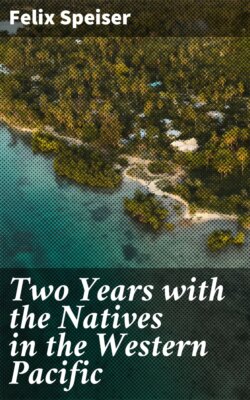Читать книгу Two Years with the Natives in the Western Pacific - Felix Speiser - Страница 5
На сайте Литреса книга снята с продажи.
Geography
ОглавлениеTable of Contents
The New Hebrides lie between 165° and 170° east longitude, and reach from 13° to 20° south latitude. The Santa Cruz Islands lie 116° east and 11° south.
The New Hebrides and Banks Islands consist of thirteen larger islands and a great number of islets and rocks, covering an area of about 15,900 km. The largest island is Espiritu Santo, about 107 x 57 km., with 4900 km. surface. They are divided into the Torres group, the Banks Islands, the Central and the Southern New Hebrides. The Banks and Torres Islands and the Southern New Hebrides are composed of a number of isolated, scattered islands, while the Central group forms a chain, which divides at Epi into an eastern and a western branch, and encloses a stretch of sea, hemming it in on all sides except the north. On the coast of this inland sea, especially on the western islands, large coral formations have grown, changing what was originally narrow mountain chains, running north and south, to larger islands. Indeed, most of them seem to consist of a volcanic nucleus, on which lie great coral banks, often 200 m. high; these usually drop in five steep steps to the sea, and then merge into the living coral-reef in the water. Most of the islands, therefore, appear as typical table-islands, out of which, in the largest ones, rise the rounded tops of the volcanic stones. They are all very mountainous; the highest point is Santo Peak, 1500 m. high.
The tides cause very nasty tide-rips in the narrow channels between the islands of the Central group; but inside, the sea is fairly good, and the reefs offer plenty of anchorage for small craft. Much less safe are the open archipelagoes of the Banks and Torres Islands and of the Southern New Hebrides, where the swell of the open ocean is unbroken by any land and harbours are scarce.
There are three active volcanoes on the New Hebrides—the mighty double crater on Ambrym, the steep cone of Lopevi, and the volcano of Tanna. There is a half-extinct volcano on Venua Lava, and many other islands show distinct traces of former volcanic activity, such as Meralava and Ureparapara, one side of which has broken down, so that now there is a smooth bay where once the lava boiled.
Rivers are found only on the larger islands, where there are volcanic rocks. In the coral rocks the rain-water oozes rapidly away, so that fresh-water springs are not frequently found, in spite of very considerable rainfall.
